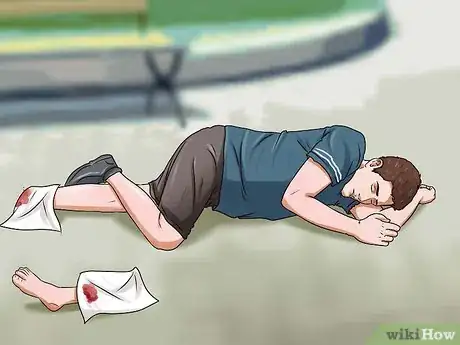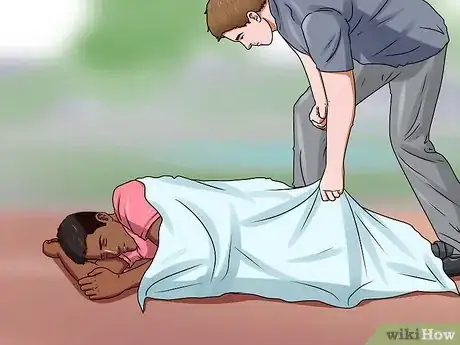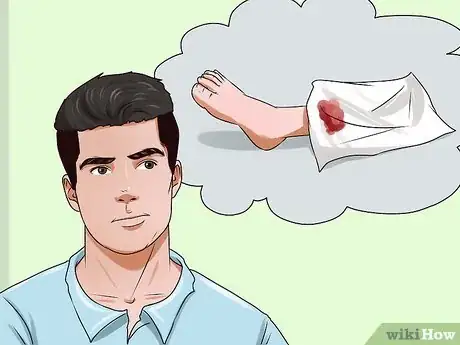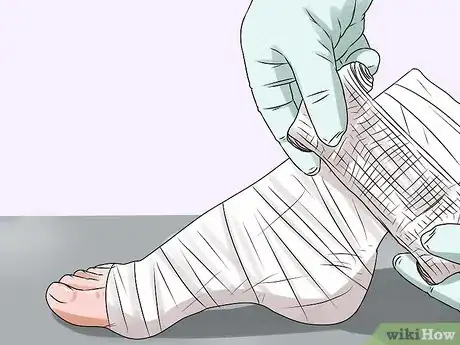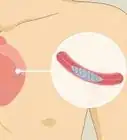This article was co-authored by Anthony Stark, EMR. Anthony Stark is a certified EMR (Emergency Medical Responder) in British Columbia, Canada. With over 11 years of experience, he has worked as an industrial medic and provided urban and rural paramedic services. He currently works for Mountain View Safety Services and previously worked for the British Columbia Ambulance Service. Anthony has a Bachelor of Engineering in Electrical, Electronics, and Communications Engineering from the Georgia Institute of Technology. He has completed the EMP Canada EMT Course and Swiftwater Awareness Training associated with the British Columbia Ambulance Service.
This article has been viewed 77,784 times.
Suffering or witnessing the separation of a limb from a body is horrible to even think about. In such a scenario, emphasis must be placed on taking care of the injured person. Call an ambulance immediately if you or someone in your vicinity has suffered the loss of a limb. While it is sometimes possible to reattach a severed limb, many factors can make reattachment impossible. Still, the chances of a successful reattachment are high enough that you should preserve a severed limb after ensuring the safety of the injured person.
Steps
Initiating Emergency Medical Care
-
1Call emergency services. You must immediately call emergency services if someone has suffered the loss of a limb. If an injury has occurred where there is no phone service, or emergency services cannot be contacted or will be unable to reach the victim, do everything you can to get the victim somewhere where you can get them additional help.
-
2Take care of the injured person first. Do not expend any attention, energy, or time on a severed limb until the injured person has been tended to. Only once breathing and circulation have been stabilized should you turn your attention to an amputated body part. Attending to the injured person must take complete precedence. The rest of this section provides some basic advice on emergency medical services.
- If it is only you and the injured person, abandon the limb and focus all of your attention on the injury. The chances of reattachment are small, and the limb should be forgotten entirely if retrieving it in any way jeopardizes the safety of the injured person.
- Do not overlook injuries that are less apparent than the amputation.[1] Most importantly, the victim must be treated for any airway or breathing issues, shock, bleeding, and infection prevention.[2]
- Do not attempt to push any body part back into place.[3]
Advertisement -
3Control bleeding. Apply direct pressure on the wound. Raise the injured area above the heart by laying the patient down if possible. Adjust and reapply pressure if bleeding continues. If substantial bleeding continues, a tight bandage or tourniquet can be used to apply the necessary amounts of direct pressure to close the wound.
- Be aware that using a tight bandage or tourniquet may ultimately damage tissue and prevent reattachment but must be employed if necessary to prevent persistent bleeding and keep the injured person alive.[4]
- Apply a direct pressure dressing firmly over the site and watch for it to bleed through. If it does, then apply a tourniquet immediately.
- If you apply a tourniquet, apply it within two to four inches of the injury site.
- Be advised that an amputated limb may not bleed profusely early in the incident, as blood vessels retract into the body as a self-defense mechanism. This DOES NOT mean there is no need to apply direct pressure, position the injury or the patient, etc. Bleeding will commence and be severe.
-
4Take steps to prevent shock. Keep the injured person warm by covering them with a coat or blanket. Lay the injured person down on flat ground. Raise the feet about 12 inches to maintain circulation and blood flow to vital organs.[5]
- Do not place the person in this position if a head, neck, back, or leg injury is suspected, as moving them may injure them further.[6] Do not place the injured victim in any position that increases their discomfort or impedes their breathing.
- Attempt to calm and reassure the injured person. While this may seem trite, it can have a significant effect on preventing the person from going into shock.
- Keep in mind that patients suffering this sort of traumatic injury can be susceptible to fast mood swings, anger, panic, etc. Do not take these things personally. Do not engage with the patient in discussing the situation. Just make general comments about the fact EMS has been called and you are with them. Try to avoid saying things like "You're ok," as this can trigger more panic.
-
5Be aware of how the type of injury affects the potential for reattachment. If the injury was caused by heavy machinery or a vehicular accident, it is extremely unlikely that the limb can be reattached, as substantial tissue damage has likely occurred. If the limb is severely damaged or contaminated, know that it will almost certainly not be re-attachable. Reattachment is more likely if the injury occurred via a sharp, clean cut, such as that from a guillotine or sharp industrial blade.
Preserving the Limb
-
1Act quickly but carefully. Proper preservation is absolutely vital. Know that no body part is too small to be potentially reattached.
-
2Gently wash the severed limb with sterile water or saline solution. Rinse, but do not scrub. If you do not have clean water or if washing the limb is not possible for another reason, skip this step.
- Do not submerge a severed limb in water, as this may cause damage that could hinder reattachment.[7]
-
3Wrap the limb in a moist, clean material.[8] Sterile gauze moistened with sterile saline solution or sterile water is best. If you do not have gauze, compromise by wrapping the limb in the cleanest absorbent material available.
- A clean t-shirt is a good second-best option. A blanket can work too, but do not use anything that is unclean. Clean maxi pads or adult diapers are also quite effective for larger amputations
- Do not moisten the material with anything other than saline solution or clean water. Wrapping the limb in a clean, dry material is better than using any unclean liquid to moisten the material.
- Paper towel will work if you do not have gauze or a clean cloth.
- A strip of tent material, sleeping bag, or hammock can be used if nothing else is available. The goal of this step (in combination with the next step) is to protect the limb from damage from the ice bath you will use to cool the limb.
-
4Wrap the limb again, this time in a watertight material. A watertight plastic container or resealable plastic bag are ideal. If you need to, compromise by using whatever you have available.
- Use a plastic shopping bag. Be sure to wrap the limb entirely and tie the handles of the bag tightly together. If you have tape or string, use it to ensure the seal.
- Use a tarp. While a tarp is waterproof, creating a reliable seal will be a challenge. Don't wrap the limb with too many layers of tarp, or you will not be able to cool the limb. Use tape and rope or whatever is available to tie the tarp snugly around the limb with as best a seal as you can create.
- Use plastic wrap. An initial layer of plastic wrap around the gauze or cloth is great, but another method of creating a water seal should be used if possible.
- Remember not to wrap the limb too tightly, as this may damage the tissue.
- Label the limb with the patient’s name and the time it was removed from the injured person's body. Skip this step if it costs significant time to do so.
Handling and Transporting the Limb
-
1Keep the limb cold. Ideally, place the container in an iced saline bath. Use a cooler or a refrigerator if possible. Do not let the limb make direct contact with ice. If you were able to cleanly protect and wrap the limb in gauze or cloth and a watertight material, the limb will be adequately protected and can be placed in the bath safely.
- If the wrap is not watertight, do not submerge the limb in an ice bath or cold water. Instead, place the limb on ice in a cooler or other vessel, making sure that some sort of material insulates the limb from direct contact with the ice.[9]
- Never use dry ice.
- Cold water can be used in lieu of an ice bath, but cleanliness is extremely important. Do not use water from a natural source for a cold bath unless you are sure you have a watertight seal around the limb.
- If a cold source is unavailable, keep the part away from any source of heat. This includes keeping it out of direct sunlight and out of places that might get hit, such as the trunk of a car on a hot day.
-
2Get to a hospital immediately. If the injured person is stable, and reattachment is viable, get the limb to the hospital (ideally traveling with the patient), as quickly as possible.
- In ideal conditions, digits can be reattached up to eight hours after detachment, while limbs will only maintain suitability for reattachment for four to six hours max.
Warnings
- Do not attempt to remove an impaled object for a severed limb, as this may damage the limb.⧼thumbs_response⧽
References
- ↑ https://www.nlm.nih.gov/medlineplus/ency/article/000006.htm
- ↑ https://www.nlm.nih.gov/medlineplus/ency/article/000006.htm
- ↑ https://www.nlm.nih.gov/medlineplus/ency/article/000006.htm
- ↑ https://www.nlm.nih.gov/medlineplus/ency/article/000006.htm
- ↑ https://www.nlm.nih.gov/medlineplus/ency/article/000006.htm
- ↑ https://www.nlm.nih.gov/medlineplus/ency/article/000006.htm
- ↑ https://www.nlm.nih.gov/medlineplus/ency/article/000006.htm
- ↑ https://www.nlm.nih.gov/medlineplus/ency/article/000006.htm
- ↑ https://www.nlm.nih.gov/medlineplus/ency/article/000006.htm

